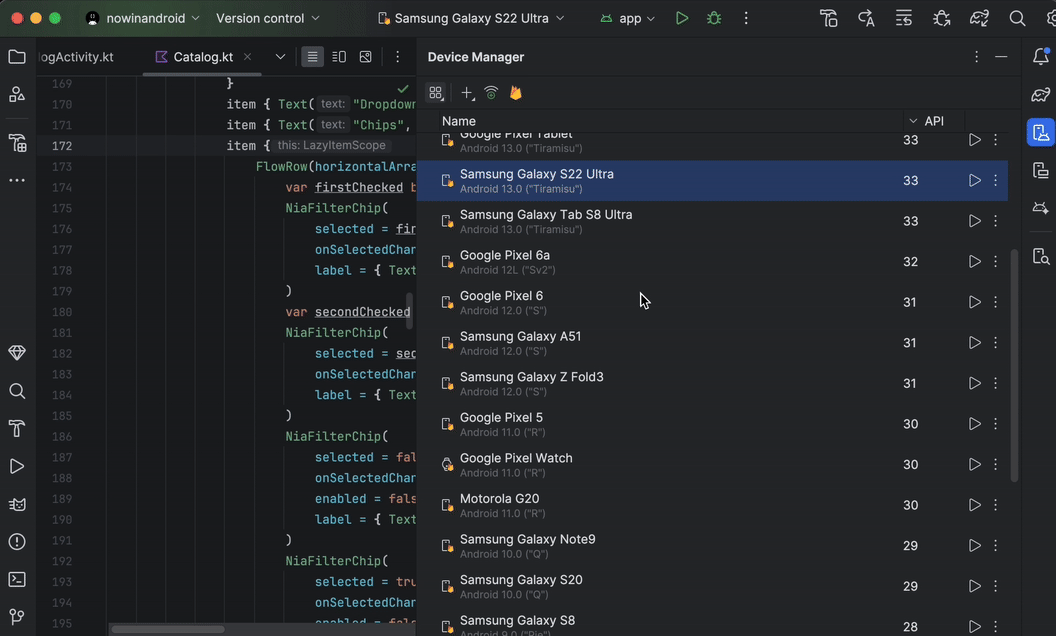
Peacock is NBCUniversal’s streaming service app available in the US, offering culture-defining entertainment including live sports, exclusive original content, TV shows, and blockbuster movies. The app continues to evolve, becoming more than just a platform to watch content, but a hub of entertainment.
Today’s users are consuming entertainment on an increasingly wider array of device sizes and types, and in particular are moving towards mobile devices. Peacock has adopted Jetpack Compose to help with its journey in adapting to more screens and meeting users where they are.
Adapting to more flexible form factors
The Peacock development team is focused on bringing the best experience to users, no matter what device they’re using or when they want to consume content. With an emerging trend from app users to watch more on mobile devices and large screens like foldables, the Peacock app needs to be able to adapt to different screen sizes. As more devices are introduced, the team needed to explore new solutions that make the most out of each unique display permutation.
The goal was to have the Peacock app to adapt to these new displays while continually offering high-quality entertainment without interruptions, like the stream reloading or visual errors. While thinking ahead, they also wanted to prepare and build a solution that was ready for Android XR as the entertainment landscape is shifting towards including more immersive experiences.

Building a future-proof experience with Jetpack Compose
In order to build a scalable solution that would help the Peacock app continue to evolve, the app was migrated to Jetpack Compose, Android’s toolkit for building scalable UI. One of the essential tools they used was the WindowSizeClass API, which helps developers create and test UI layouts for different size ranges. This API then allows the app to seamlessly switch between pre-set layouts as it reaches established viewport breakpoints for different window sizes.
The API was used in conjunction with Kotlin Coroutines and Flows to keep the UI state responsive as the window size changed. To test their work and fine tune edge case devices, Peacock used the Android Studio emulator to simulate a wide range of Android-based devices.
Jetpack Compose allowed the team to build adaptively, so now the Peacock app responds to a wide variety of screens while offering a seamless experience to Android users. “The app feels more native, more fluid, and more intuitive across all form factors,” said Diego Valente, Head of Mobile, Peacock and Global Streaming. “That means users can start watching on a smaller screen and continue instantly on a larger one when they unfold the device—no reloads, no friction. It just works.”
Preparing for immersive entertainment experiences
In building adaptive apps on Android, John Jelley, Senior Vice President, Product & UX, Peacock and Global Streaming, says Peacock has also laid the groundwork to quickly adapt to the Android XR platform: “Android XR builds on the same large screen principles, our investment here naturally extends to those emerging experiences with less developmental work.”
The team is excited about the prospect of features unlocked by Android XR, like Multiview for sports and TV, which enables users to watch multiple games or camera angles at once. By tailoring spatial windows to the user’s environment, the app could offer new ways for users to interact with contextual metadata like sports stats or actor information—all without ever interrupting their experience.
Build adaptive apps
Learn how to unlock your app's full potential on phones, tablets, foldables, and beyond.
Explore this announcement and all Google I/O 2025 updates on io.google starting May 22.
 Posted by Adarsh Fernando, Senior Product Manager, Android Developer Tools
Posted by Adarsh Fernando, Senior Product Manager, Android Developer Tools




